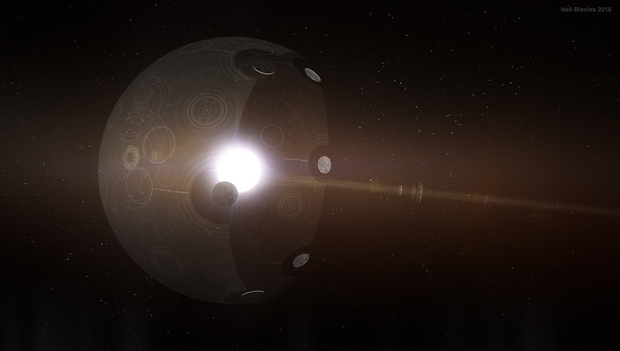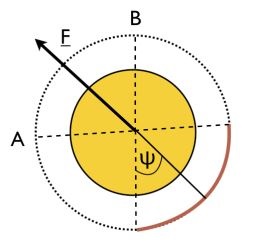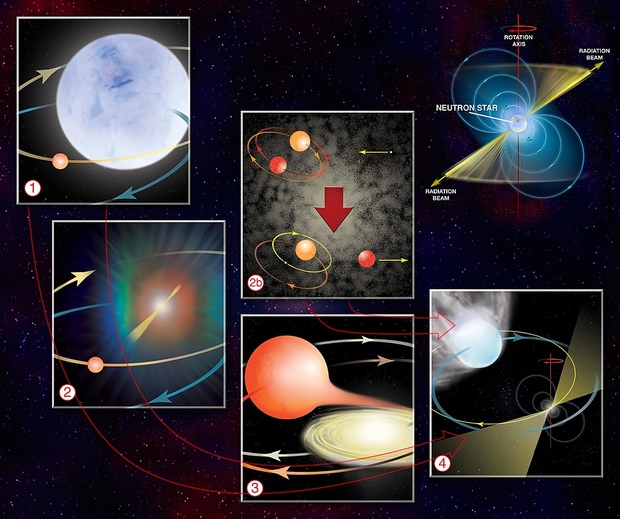Suppose you want to migrate to another star, taking your entire civilization with you. Not an easy task given our technology today, but let’s remember that in the 13 billion year-plus history of the Milky Way, countless stars and their planets have emerged that are far older than our 4.6-billion year old Sun. If we imagine an intelligence that survives for a billion years or more, we can hardly put constraints on what it might accomplish. The idea of moving a star with its planetary system intact is out there on the edge of what science fiction can accomplish, if not yet science. There have even been SETI searches for such projects, though as with SETI at large, no hits.
Why would you want to move a star? Consider that if you are a long-lived species with a simple interest in exploring the universe, setting up a journey in which you can take your culture with you – all of it – could have serious appeal. For one thing, you are also taking your primary energy source with you, and can now settle into a traveler’s frame of mind, confident of reaching exotic destinations sooner or later. Slow boat to the heart of the Laniakea Supercluster, and imagine the sights to be had along the way.
Imagine a culture in which extraordinarily long lifetimes – perhaps ‘immortality’ for a machine civilization – is the norm. The accelerated expansion of the universe will continue rendering some destinations unreachable. Dan Hooper, in a paper called “Life Versus Dark Energy: How An Advanced Civilization Could Resist the Accelerating Expansion of the Universe,” considered this in 2018; we’ll be looking at his ideas in the near future. Perhaps migrating to a globular cluster or into the tightly packed center of a galaxy would suggest itself as a goal worth achieving. But let’s not dig too far into motivations. What could humans possibly understand about the motivations of a billion-year old culture? Let’s just look for observables. So how about this:

Image: This is Figure 3 from the paper by Clément Vidal we’ll be discussing today. Caption: The original black widow pulsar PSR J1959+2048. Left: the BW pulsar (in blue) is plotted in the RA-DEC plane, and its proper motion vector is displayed until it reaches a close encounter with a target star, in orange, whose Gaia DR3 ID is displayed (see Vidal et al. 2023 [60] for the method used to find close encounters). Middle: a Chandra X-ray view of the BW pulsar, displaying a comet-like tail; the candidate target star is also visible in the bottom right (visualization with ESASky). Right: The composite image on the right shows the X-ray tail (in red/white) and a bow shock visible in the optical (green). Credit: X-ray: NASA/CXC/ASTRON/B. Stappers et al. [38]; Optical: AAO/J.Bland-Hawthorn & H.Jones; scale: 1.2 arcmin on a side.
We’ll get to the terminology involved in that caption in a moment. For now, is this conceivably a stellar engine in motion toward a nearby star? Probably not, but I introduce this image because I suspect that SETI searches for stellar engines are not well known, although they have been performed and we’ll be looking at these soon. And it also introduces the possibilities of an entirely different kind of stellar engine.
It’s no surprise that it should emerge through the work of Clément Vidal, given the philosopher’s long-standing interest in deep time and societies that go back to the early eons of the universe. Vidal (Center Leo Apostel, Vrije Universiteit Brussel, Belgium) is the author of the essential The Beginning and the End (2014) which along with his papers explores the terrain of matter and energy as a means of increasing order, and the possibility of locating ancient civilizations by finding what appear to be natural objects conceivably being manipulated by engineering on scales that we can only imagine.
Vidal’s latest plunges into what he calls the ‘Spider Stellar Engine,’ a steerable design using binary star pairs as parts of a propulsive system that uses one star as payload and the other as fuel. If this reminds you of Olaf Stapledon, you’re right, as it was he who wrote about artificial stars created to support interstellar voyaging in the 1930s. But I’m glad to see Vidal also pointing to Fritz Zwicky, who has all too often been overlooked in the history of exotic concepts even though it turns out that on matters like dark matter, he was far ahead of the game. Here’s Zwicky on stellar engines:
“Considering the Sun itself, many changes are imaginable. Most fascinating is perhaps the possibility of accelerating it to higher speeds, for instance 1,000 km/s directed toward α-Centauri in whose neighborhood our descendants then might arrive a thousand years hence. All of these projects could be realized through the action of nuclear fusion jets, using the matter constituting the Sun and the planets as nuclear propellants.”
Various science fiction authors have explored the concept, and Stanley Schmidt even came up with an assist from aliens offering to boost the Earth to another stellar system to save it in Sins of the Fathers (1977). But the most technically judicious treatment of moving an entire system like this is probably the one depicted in Greg Benford and Larry Niven’s Bowl of Heaven series, which in turn draws on the thinking of the Russian engineer and scientist Leonid Shkadov (1927–2003). As with Dyson spheres, here we are in the domain of engineering at a colossal scale.

Image: A Shkadov thruster at work. Credit: Greg School.
Let’s give Shkadov his due before exploring Vidal’s new concept. A Shkadov thruster works through a balancing act. A semi-spherical mirror is positioned in such a way that the pressure of solar photons balances the gravitational force of the star on the mirror. Achieve this and the radiation hitting the mirror reflects back toward the star, producing an imbalance that creates thrust. Here’s a diagram from a paper by Duncan Forgan (University of Edinburgh) that is the best I can find to illustrate the concept:

This is Figure 1 from Duncan Forgan’s paper “On the Possibility of Detecting Class A Stellar Engines Using Exoplanet Transit Curves (citation below).” The treatment of Shkadov thrusters is useful, and I insert the diagram here because the Vidal paper only offers a short explanation of the original concept. Forgan’s caption: Diagram of a Class A Stellar Engine, or Shkadov thruster. The star is viewed from the pole – the thruster is a spherical arc mirror (solid line), spanning a sector of total angular extent 2ψ. This produces an imbalance in the radiation pressure force produced by the star, resulting in a net thrust in the direction of the arrow. Credit: Duncan Forgan.
Clément Vidal brings into the stellar engine mix the idea of using binary millisecond pulsars. You may recall Vidal’s stellivore concept, which we’ve discussed over the years in Centauri Dreams. Here’s how he describes it in the current paper:
…the stellivore hypothesis, that reinterprets some observed accreting binary stars as advanced civilizations feeding on stars… The scenario would be the following. For most of its time, a stellivore civilization would eat its home star via accretion. However, energy is never eternal, and instead of eating its star until the end and dying, a stellivore civilization would use its low-mass companion star as fuel not to be accreted, but to be evaporated, in order to create thrust and travel towards a nearby star. The fundamental accretion dynamics of close binaries would be reversed into an evaporation dynamics.
In the new paper, Vidal homes in on so-called spider pulsars, which are binary systems made up of one millisecond pulsar and a low-mass companion star. This in itself has always struck me as an extraordinary situation. We’re positing a massive star in a binary system that becomes a supernova and leaves behind a neutron star. In many cases, the binary system (i.e., the companion star) survives this event, allowing the neutron star thereafter to draw material out of it through accretion. It’s this transfer of mass that ‘spins’ up the neutron star – this is simple transfer of angular momentum – so that the neutron star can rotate at millisecond rates.
I haven’t seen any figures on what percentage of binary systems can survive a supernova event, but it’s telling that a high proportion of millisecond pulsars are indeed found in binary systems. Millisecond pulsars (MSPs) are detectable when the beam of electromagnetic radiation they emit sweeps past our observing apparatus.

Image: This diagram shows the steps astronomers say are needed to create a pulsar with a superfast spin. 1. A massive supergiant star and a “normal” Sun-like star orbit each other. 2. The massive star explodes, leaving a pulsar that eventually slows down, turns off, and becomes a cooling neutron star. 3. The Sun-like star eventually expands, spilling material on to the neutron star. This “accretion” speeds up the neutron star’s spin. 4. Accretion ends, the neutron star is “recycled” into a millisecond pulsar. But in a densely packed globular cluster (2b)… The lowest mass stars are ejected, the remaining normal stars evolve, and the “recycling” scenario (3-4) takes place, creating many millisecond pulsars. Credit: B. Saxton, NRAO/AUI/NSF.
A spider pulsar as described by Vidal is made up of a one millisecond pulsar and a relatively small companion. And here we get the unusual evaporation effect that the above quote references. Rather than accreting matter from the companion star, a spider pulsar system evaporates the companion star. Hence the ‘spider’ metaphor, referring to female spiders that eat their male companion after mating. Get the right configuration and you have what Vidal calls a spider stellar engine. How it can be used to accelerate, decelerate and steer over interstellar distances takes up much of the paper. More on that next time.
In this kind of engine, the payload is a neutron star of about 1.8 solar masses. The propellant is the low-mass companion star somewhere between 0.01 and 0.7 solar masses. And where are the passengers; i.e., the civilization that is transporting itself around the galaxy? We have a lot to discuss here, and I also want to dig into the Hooper paper referenced above as well as the subject of hypervelocity stars, which are possible instances of stellar engineering technosignatures. We continue next time, with an email exchange I’ve been having with Vidal and the fine-tuning of stellar engines.
Clément Vidal’s new paper is “The Spider Stellar Engine: a Fully Steerable Extraterrestrial Design?” Journal of the British Interplanetary Society Vol. 77 (2024), 156-166 (preprint). Leonid Shkadov’s original paper on the Shkadov thruster is “Possibility of controlling solar system motion in the galaxy,” 38th Congress of IAF,” October 10-17, 1987, Brighton, UK, paper IAA-87-613. The Forgan paper is “On the Possibility of Detecting Class A Stellar Engines Using Exoplanet Transit Curves,” accepted at the Journal of the British Interplanetary Society (preprint).



While I don’t really believe an ETI would do this, for a variety of reasons, it is still an interesting thought experiment. A few thoughts come to mind.
First, every stellar system, including our own, is already on this type of voyage. We don’t control the trajectory but we are traveling through a large section of the galaxy. It doesn’t seem that way since we’re short-lived, but a more advanced civilization might see the situation differently.
Second, the galaxy is not static. For example, the spectacular features of the Orion nebula will be gone in a few hundred thousand years. We must either travel there quickly to see it up close or we must predict similar phenomena so that they come to exist after a long travel time.
Third, it is not enough to accelerate the star since the planets and the rest of its companions will be left behind. There is a tightly constrained set of trajectories that have a chance of carrying along the entire system. That matter if ET still lives on planets. The allowed trajectories are those approximately axial; that is, orthogonal to the plane of the orbiting objects. They essentially “corkscrew” around the star. Otherwise they will not follow. Lightly bound objects, such as our KBO, would not follow unless the acceleration is very low.
I know that the last has been mathematically modeled and studied. Someone with the time to search might be able to find the paper(s).
Such ambitious engineering makes me wonder if we mere humans might envisage more local projects such as changing the Earth’s tilt, moving continents around, spinning up the Moon, moving Earth to a higher orbit to counteract the heating sun, and so forth.
I’ve been considering a more practical approach: a Gerard K. O’Neill mass driver in orbit around the Moon. This would function like a particle accelerator, with a diameter of 3,000 miles and generating 1 to 3 Gs of force to propel people to Mars. A good question to explore is how fast this system could actually send travelers and how long the journey to Mars would take.
Solar panels would provide energy to keep the superconductors shielded and at a low temperature, and we could build the mass driver using materials launched from mass drivers on the Moon. Additionally, it might be possible to transform Phobos into a receiving mass driver orbiting Mars. It sounds like it would be one incredible roller coaster ride!
IIRC, this was a mode of travel in a SciFi story I have read [KSRs Red Moon for travel between Earth and Moon? Also intra-Moon travel in Clarke’s Maelstrom II, and Ian McDonald’s Luna triology.]. It does require a decelerating mass driver at the destination, otherwise it is strawberry jam.
Precision is important, but we seem to have that already with the recent set of Mars probes and even ones to the outer planets, so with small thrusters to ensure perfect navigation, this should be a viable approach.
Now extend the idea from a capsule, or small spaceship, to a rotating habitat. To keep the mass low, the habitat would have a central core and multiple living areas on extensible tubes. The vehicle would be launched in a compact configuration, and in space the the living areas would be extended and the whole structure spun up to provide 1g for travel comfort. A full, cylindrical O’Neill could be launched this way with sufficiently sized mass drivers. I would expect the mass driver to be fully circular around the lunar equator to allow multiple circuits to accelerate the habitats before release, just like terrestrial particle accelerators.
In summary, I think this is a viable approach for vehicles, at least for the smaller ones. The scale comes later.
But what about using the mass driver to move the Moon? Think of large populations living in the Moon (c.f. Varley’s Steel Beach) and using the Moon’s mass as propellant to eventually break free from Earth’s gravitational influence and travel inside and even beyond the solar system. Assume 1/2 of the Moon was consumed for propellant, and the mass driver could accelerate the propellant to ~30 km/s (0.0001 C), then the Moon would eventually break free of the sun and travel as a generation ship to the stars (very, very slowly).
Agreed…I might want a pulsar pushed towards any threat objects—not move our system
We know that our sun probably originated near the galactic center and describes a spiral movement away from the edges of the galaxy due to the rotation of the latter. We can assume that an ETI civilization can therefore also see this movement and even provide a meeting path if it wants to say hello. However, the whole question is whether this movement is natural and due to the forces in the presence or if it is a movement “controlled” by another ETI ? Would it move solar systems for nothing? Not sure…
The research of C. Vidal is exciting because he gives another dimension (huge) to our universe and therefore a different point of view.
I am amazed by this incredible image of the Pulsar in motion and by this “arc” that it produces before him that I do not explain well…
I will read his paper.
Fred
Several “Runaway Stars” have been detected, moving very fast; 3 of them running away from the same spot in the Orion nebula. Are they fleeing some catastrophe?
Has anybody checked those stars for possible planetary companions?
Maybe we wouldn’t find any; the planets might have been dismantled to build billions of habitats.
And I hope this isn’t too far off-topic, but how much time and money do these searches for exoplanets take? Could somebody with lots of money persuade some university grad students to do an examination of a particular star?
No, I’m not really planning to make such a request, I just wondered if it were possible.
Relativistic electron beam could propel probe to Alpha Centauri, study suggests
by Andy Tomaswick
Universe Today
https://phys.org/news/2025-01-relativistic-electron-propel-probe-alpha.html